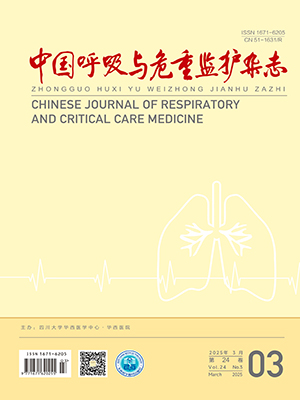Objective To study the clinical feasibility of invasive mechanical ventilation with bilevel positive airway pressure(BiPAP) non-invasive ventilator in the stable patients needing prolonged mechanical ventilation.Methods Eleven patients with respiratory failure admitted in intensive care unit(ICU)of our department,who needed prolonged mechanical ventilation,between Jun 2004 and Nov 2007 were enrolled in the study and followed until death or Jan 2008.The arterial blood gas analysis data,length of stay(LOS),LOS after changing to BiPAP non-invasive ventilator(Synchrony,Harmony,RESPIRONICS,VPAP III ST-A,RESMED),survival time after discharge(or fulfilled the discharge standards) were reviewed retrospectively.Results The settings of inspiratory pressure,expiratory pressure and respiratory rate of non-invasive ventilation were 21.3 (16-26) cm H2O,4 cm H2O,and 16 min-1,respectively.The LOS (or up to the discharge standard) was (91.5±50.2) days.The LOS (or up to the discharge standard) after changing to BiPAP ventilator was (23.5±12.2) days.The mean survival time after discharge (or up to the discharge standard) was (353.1±296.5) days.Four patients were still alive up to the end of the study.The arterial pH,PaCO2,PaO2,and SaO2 were not significant different before and after changing to BiPAP ventilator.Conclusion The mechanical ventilation with BiPAP non-invasive ventilator via tracheotomy tube is an alternative choice for stable patients needing prolonged mechanical ventilation.
Citation:
MA Zhuang,SHI Liang,HUAI Yongjun,XIE Hua,LIN Yuhong,LIU Lei. Clinical analysis of invasive mechanical ventilation with bilevel positive airway pressure non-invasive ventilator. Chinese Journal of Respiratory and Critical Care Medicine, 2008, 08(3): 187-189. doi:
Copy
Copyright © the editorial department of Chinese Journal of Respiratory and Critical Care Medicine of West China Medical Publisher. All rights reserved
| 1. |
O’Donohue WJ Jr,Giovannoni RM,Goldberg AI,et al.Long-term mechanical ventilation.Guidelines for management in the home and at alternate community sites.Chest,1986,90(1 Suppl):1S-37S.
|
| 2. |
Farre R,Lloyd-Owen SJ,Ambrosino N,et al.Quality control of equipment in home mechanical ventilation:a European survey.Eur Respir J,2005,26:86-94.
|
| 3. |
Rady M,Johnson DJ.Hospital discharge to care facility:a patient-centered outcome for the evaluation of intensive care for octogenarians.Chest,2004,126:1583-1591.
|
| 4. |
曾祥毅,王小平,张琼,等.双水平无创正压通气对急性肺损伤的治疗价值.中国呼吸与危重监护杂志,2006,5:432-434.
|
| 5. |
向平超,杨珺楠,郭伟安,等.无创正压通气救治慢性阻塞性肺疾病并重度呼吸衰竭的临床探讨.中国呼吸与危重监护杂志,2006,5:16-18.
|
| 6. |
Lewarski JS.Long-term care of the patient with a tracheostomy.Respir Care,2005,50:534-537.
|
| 7. |
Heffner JE,Hess D.Tracheostomy management in the chronically ventilated patient.Clin Chest Med,2001,22:55-69.
|
| 8. |
MacIntyre NR,Epstein SK,Carson S,et al.Management of patients requiring prolonged mechanical ventilation:report of a NAMDRC consensus conference.Chest,2005,128:3937-3954.
|
| 9. |
Griffiths J,Barber VS,Morgan L,et al.Systematic review and meta-analysis of studiesof the timing of tracheostomy in adult patients undergoing artificial ventilation.BMJ,2005,330:1243.
|
- 1. O’Donohue WJ Jr,Giovannoni RM,Goldberg AI,et al.Long-term mechanical ventilation.Guidelines for management in the home and at alternate community sites.Chest,1986,90(1 Suppl):1S-37S.
- 2. Farre R,Lloyd-Owen SJ,Ambrosino N,et al.Quality control of equipment in home mechanical ventilation:a European survey.Eur Respir J,2005,26:86-94.
- 3. Rady M,Johnson DJ.Hospital discharge to care facility:a patient-centered outcome for the evaluation of intensive care for octogenarians.Chest,2004,126:1583-1591.
- 4. 曾祥毅,王小平,张琼,等.双水平无创正压通气对急性肺损伤的治疗价值.中国呼吸与危重监护杂志,2006,5:432-434.
- 5. 向平超,杨珺楠,郭伟安,等.无创正压通气救治慢性阻塞性肺疾病并重度呼吸衰竭的临床探讨.中国呼吸与危重监护杂志,2006,5:16-18.
- 6. Lewarski JS.Long-term care of the patient with a tracheostomy.Respir Care,2005,50:534-537.
- 7. Heffner JE,Hess D.Tracheostomy management in the chronically ventilated patient.Clin Chest Med,2001,22:55-69.
- 8. MacIntyre NR,Epstein SK,Carson S,et al.Management of patients requiring prolonged mechanical ventilation:report of a NAMDRC consensus conference.Chest,2005,128:3937-3954.
- 9. Griffiths J,Barber VS,Morgan L,et al.Systematic review and meta-analysis of studiesof the timing of tracheostomy in adult patients undergoing artificial ventilation.BMJ,2005,330:1243.




